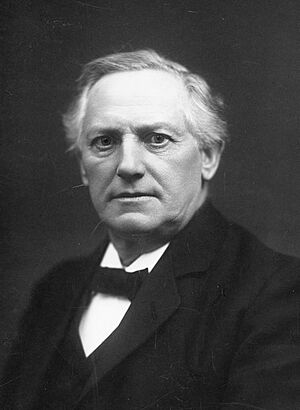Jørgen Pedersen Gram facts for kids
Quick facts for kids
Jørgen Pedersen Gram
|
|
|---|---|
 |
|
| Born | 27 June 1850 Nustrup, Duchy of Schleswig, Denmark
|
| Died | 29 April 1916 (aged 65) |
| Known for | Gram matrix Gram points Gram polynomials Gram's theorem Gram–Charlier A series Gram–Euler theorem Gram–Schmidt process |
Jørgen Pedersen Gram (born June 27, 1850 – died April 29, 1916) was a brilliant Danish mathematician. He was also an actuary, someone who studies risks. Gram made many important discoveries in math. He was born in Nustrup, Denmark, and passed away in Copenhagen.
Contents
Gram's Important Math Work
Jørgen Gram wrote several important papers during his life. These papers shared his new ideas and methods in mathematics. His work helped other scientists solve complex problems.
The Gram–Schmidt Process
One of Gram's most famous contributions is the Gram–Schmidt process. He first wrote about this method in 1883. It helps mathematicians and engineers work with sets of vectors. Imagine you have a messy pile of building blocks. This process helps you arrange them neatly. It makes them all point in different, clear directions. This is very useful in areas like computer graphics and data analysis.
Understanding Prime Numbers
Gram also studied prime numbers. These are numbers that can only be divided by 1 and themselves. He wrote a paper called Investigations of the number of primes less than a given number. This paper explored how many prime numbers exist up to a certain point.
Gram and the Riemann Zeta Function
Gram developed a special way to calculate the Riemann zeta function. This function is very important for understanding prime numbers. It helps mathematicians predict where primes might appear. Gram's method used powers of logarithms. It also used the zeta function of positive whole numbers. His work was a big step forward in number theory.
The Gram Matrix
Another key idea from Gram is the Gram matrix. This is a special kind of table (or matrix) of numbers. It is used in many different fields.
Gram Matrix in Control Systems
In control theory, the Gram matrix is super important. Control theory is about making systems behave the way you want. Think about how a self-driving car stays on the road. The Gram matrix helps engineers check if a system is stable. It also helps them see if they can control it properly.
Gram Matrix in Deep Learning
The Gram matrix is even used in modern computer science. It helps with something called deep learning. This is where computers learn from huge amounts of data. For example, in "style transfer," the Gram matrix helps a computer learn the artistic style of one image. Then, it can apply that style to another image. This lets you turn a photo into a painting!
Skew Frequency Curves
Gram was the first to create a clear theory for "skew frequency curves." Imagine you are tracking how often certain things happen. A "normal" curve looks like a bell. But sometimes, the data isn't perfectly balanced. It might be "skewed" to one side. Gram showed that the normal bell curve was just one example. He developed a more general way to understand these uneven patterns. This helps scientists analyze all sorts of data.
Other Contributions
Several other important mathematical ideas are named after Jørgen Gram. These include Gram's theorem, the Gram–Charlier series, and Gram points. These show how wide-ranging and important his work was.
His Final Days
Jørgen Gram sadly passed away on April 29, 1916. He was on his way to a meeting of the Royal Danish Academy of Sciences and Letters. He was hit by a cyclist and died from his injuries.

